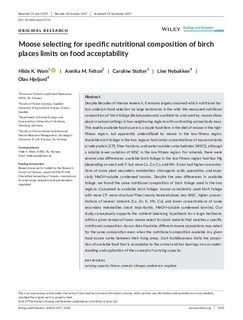| dc.description.abstract | Despite decades of intense research, it remains largely unsolved which nutritional factors underpin food selection by large herbivores in the wild. We measured nutritional composition of birch foliage (Betula pubescens) available to, and used by, moose (Alces alces) in natural settings in two neighboring regions with contrasting animal body mass. This readily available food source is a staple food item in the diet of moose in the high-fitness region, but apparently underutilized by moose in the low-fitness region. Available birch foliage in the two regions had similar concentrations of macronutrients (crude protein [CP], fiber fractions, and water-soluble carbohydrates [WSC]), although a notably lower variation of WSC in the low-fitness region. For minerals, there were several area differences: available birch foliage in the low-fitness region had less Mg (depending on year) and P, but more Ca, Zn, Cu, and Mn. It also had higher concentrations of some plant secondary metabolites: chlorogenic acids, quercetins, and especially MeOH-soluble condensed tannins. Despite the area differences in available foliage, we found the same nutritional composition of birch foliage used in the two regions. Compared to available birch foliage, moose consistently used birch foliage with more CP, more structural fiber (mainly hemicellulose), less WSC, higher concentrations of several minerals (Ca, Zn, K, Mn, Cu), and lower concentrations of some secondary metabolites (most importantly, MeOH-soluble condensed tannins). Our study conceptually supports the nutrient-balancing hypothesis for a large herbivore: within a given temporal frame, moose select for plant material that matches a specific nutritional composition. As our data illustrate, different moose populations may select for the same composition even when the nutritional composition available in a given food source varies between their living areas. Such fastidiousness limits the proportion of available food that is acceptable to the animal and has bearings on our understanding and application of the concept of carrying capacity. | |

